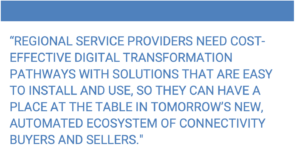
on Posted on Reading Time: 4 minutes
Today, there are nearly 3,000 internet service providers in the United States, and tens of thousands more globally. Outside of a small handful of well-known national names, the majority are regional, primarily specializing in delivering connectivity to regions outside of the major metropolitan hubs. The services they offer vary – from Ethernet and broadband, to satellite, fixed wireless, and more. Simply put, regional service providers play an important role in our digital future.
Why Regional Service Providers Matter 
Coverage: Regional service providers are helping address America’s digital divide by building faster rural internet connections and providing critical backhaul support for new 5G networks. In addition, regional providers support national operators by delivering the wholesale connectivity their enterprise business depends upon.
Innovation: Local interconnection improves the performance of new digital applications and cloud data centers. By providing connectivity closer to where the services are delivered (the ‘edge’), latency is reduced and new IoT services are enabled. This area offers huge growth potential for regional service providers, with edge computing expected to grow between 40 and 70% by 2028. ‘Smart’ college campuses, farms, and manufacturing plants are just a few examples reliant upon the last mile connections of regional providers.
Community: Many regional service providers play an important role in their communities by providing valuable jobs and local support. Internet connectivity itself is a foundation for economic growth across communities. In a recent survey by Paulsen and Audience Audit, 67% of respondents said they would consider moving to a rural or suburban area, but the deciding factor would be internet access.
National Operators Need Regional Service Providers’ Expertise and Reach
Many Tier 1 service providers generate over one thousand orders per month for ‘off-net’ circuits. These off-net orders allow service providers to support enterprise customers who open new business locations outside of their own network footprint. For every off-net retail telecom transaction, there is a complex series of wholesale transactions that must happen in the background. While these orders may only make up a smaller percentage of retail telecom transactions for national service providers, they are a critical piece of delivering end-to-end connectivity to a growing and lucrative enterprise customer base. A big portion of regional service provider revenue comes from these and other wholesale transactions, and this is expected to continue with the rise in IoT and edge data centers.
Intercarrier Challenges
Despite the importance of intercarrier business, the process is fraught with frustration. Off-net Ethernet orders can still take more than 90 days to deliver, partly because they are often still managed by email, phone, or fax. Broadband and SD-WAN services are even more complex and labor intensive when it comes to finding and ordering the right services. There are no common ordering standards – it’s basically the Wild West. And once these services are turned up, it can be difficult for the ‘home’ operator to know if their enterprise customers are receiving the quality connectivity they’re paying for. This lack of order automation and service visibility will become real stumbling blocks for economic progress as demand for digital services continues to grow.
Intercarrier Order Automation is Coming—but will it create a new digital divide?
Improvements in how off-net interconnect services are bought and sold are underway. Software vendors like TransUnion and organizations like MEF are working to streamline operations by developing automated workflows and a set of standardized APIs and best-practices that can be shared across the ecosystem. Service providers know this, and many are ready for change. In fact, according to a survey by Heavy Reading, over 40% of service providers plan to automate their order management functions over the next 12 months.
MEF’s Lifecycle Service Orchestration (LOS) Sonata is a set of APIs that have been developed to provide frictionless inter-provider commerce. These APIs have already been adopted by some of the leading national operators, and now this ecosystem needs to expand to include the regional service providers for the real business benefits to begin. But this is easier said than done.
There are significant hurdles that regional providers face when it comes to upgrading business infrastructure, especially when it involves complex, long-term IT projects.
Regional Service Provider Challenges in Automating Back Office Systems
- Making the business case
- Justifying the cost of technology
- Gaining access to the right skills and IT resources
MEF Sonata LSO is the future of intercarrier commerce, but building to these new standards is a complex and time-consuming process. Full implementation can take even national carriers with big IT teams and budgets close to a year to achieve. How can regional providers compete? The industry needs to avoid creating an uneven playing field—an environment of digital transformation ‘have and have-nots’—where only the largest operators are able to do business in an automated way. In this universe, no one wins.
Digital Transformation—Simplified
At TransUnion, we believe digital transformation is critical for success, but not every service provider is able to take the same road. We are working with MEF to create cost-effective digital transformation pathways with solutions that are easy to install and use, so regional carriers can have a place at the table in tomorrow’s new, automated ecosystem of connectivity buyers and sellers.
It’s up to the telecom community to make sure that progress for some doesn’t mean closing the door on others. Let’s work together to find ways to make transformation projects:
- Affordable
- Easy-to-implement
- Easy-to-use
- Results oriented
- Low risk
In closing, back-office digital transformation efforts have become vitally important for carriers around the globe to remain competitive and to keep up with changing customer expectations. As an approved MEF LSO API Solution Provider, TransUnion wants to make sure every service provider—regardless of its size—has what it needs to succeed.
Learn More
Learn more about TruContact™ UOC Marketplace, Powered by Neustar®, a cloud-based solution that streamlines how wholesale connectivity services are marketed, sold, and managed.
Also read the blog: How Automation and APIs Help Fast-track Business Broadband to Rural Areas
Listen to the Executives at the Edge Podcast: Automating Inter-Carrier Ordering: A Transformational Effort

